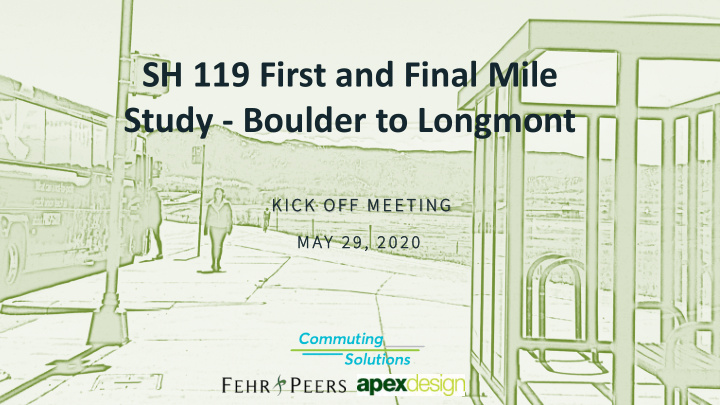



SH 119 First and Final Mile Study - Boulder to Longmont K I C I CK O F F M F F M E E T I T ING M A M AY 2 9 , 2 0 2 0 2 9 , 2 0 2 0
INTRODUCTIONS
INTRODUCTIONS ROUNDTABLE • Name • Organization • Connection to SH 119
PROJECT BACKGROUND
PROJECT BACKGROUND WHAT IS THE FIRST AND FINAL MILE GAP A first or final mile gap is a barrier that discourages potential riders from • using transit because a station cannot be easily accessed from home, work, or other destinations Can include trip distances, street network and design, or a lack of available • transportation options The easier it is to access the system, the more likely people are to use it •
PROJECT BACKGROUND PROPOSED BUS RAPID TRANSIT (BRT) What is Bus R Rapi pid T d Transit ( (BRT)? A proven bus-based transit system that delivers fast, comfortable and reliable service • Limited stops to improve speed, reduce travel time and maximize ridership • Source: RTD, https://www.rtd-denver.com/projects/state-highway-119-brt-study
PROJECT BACKGROUND PROPOSED BUS RAPID TRANSIT (BRT) Vision for SH H 119 B 9 BRT Two BRT (blue and orange) routes with • different alignments and frequencies Center-running lanes for buses, HOV, • and toll-paying users 15 and 30-minute service • Intersection improvements • Branded to create a visual identity • Technology Improvements (ITS) • Pre-board fare collection • 5 Park-n-Rides • Supplements future rail •
PROJECT BACKGROUND PROPOSED BIKEWAY Vision for SH 1 119 B Bikewa way Multi-use path running • along the center of SH 119 7.7 miles long from • 47 th Street (Boulder) to Fordham Street (Longmont) Connects to existing trail • systems in Boulder and Longmont
PROJECT BACKGROUND PREVIOUS PLANNING EFFORTS SH 119 BRT PEL • SH 119 BRT support memos • SH 119 Bikeway alignment • Boulder Low- Stress Walk and Bike Plan • Boulder Pedestrian Plan • Boulder Transportation Master Plan • CU Boulder Transportation Master Plan • Longmont Enhanced Multi-use Corridors Plan • Longmont Multimodal Transportation Implementation Plan • Longmont 119 BRT Alignment Analysis • Boulder County Transportation Master Plan • RTD First and Final Mile Strategy Study • SH 119 BRT Traffic Analysis Report •
PROJECT BACKGROUND FUNDING AND IMPLEMENTATION Funded E Elements (2020-2024 ) Unf nfund nded E Elements (T (TBD) Bikeway design and environmental Construction of bikeway • • clearance Center running lanes for buses, • BRT service/vehicles HOV, and toll paying users • Park-n-rides Boulder/Longmont intersection • • improvements Intersection improvements • at SH 119 & SH 52 Additional local bus priority lanes • Coffman Street busway (Longmont) • Bus priority lanes (Boulder, 28 th St.) •
BASELINE DATA
BASELINE DATA TRANSIT RIDERSHIP 2,250 1,690 SH 119 Corridor Average Daily Weekday Ridership Sources: • Existing - from RTD RideCheckPlus • Future - SH 119 Multi- modal Planning and Environmental Linkages Study (PEL), 2019 2019 (Existing BOLT & J) 2040 (Future BRT)
BASELINE DATA FUTURE GROWTH Population Growth Employment Growth (2015-2040) (2015-2040) 100% 72% 24% 23% 20% 18% 15% 10% Boulder Boulder SH 119 (Between Boulder and Longmont) SH 119 (Between Boulder and Longmont) Longmont Longmont Weld County Weld County Sources: Boulder, SH 119, Longmont: SH 119 Multi-modal Planning and Environmental Linkages Study (PEL), 2019 Weld County: Colorado State Demography Office ( https://demography.dola.colorado.gov/)
BASELINE DATA MODE SPLIT (PM PEAK HOUR) Existing (2018) Future with BRT (2040) Bicycle Bicycle Transit Transit 1% 2% 5% 6% Carpool Carpool 26% 28% Drive Drive Alone Alone 65% 69% Walking: <1% Walking: <1% Drive Alone Carpool Drive Alone Carpool Transit Bicycle Transit Bicycle Source: PEL SH 119 2040 Person Throughput Analysis UDATED (November 9, 2018)
BASELINE DATA EXISTING VEHICLE SPEEDS Southbound - 50 th Percentile Speed (85 th Percentile Speed) MPH Northbound - 50 th Percentile Speed (85 th Percentile Speed) MPH In 2040: 26 minutes travel time savings on the BRT compared to BOLT/J Data Collected: 12/03/19 - 12/05/19
BASELINE DATA TRAFFIC VOLUMES 2018 Annual Average Daily Traffic Volume Source: CDOT’s Online Transportation Information System (OTIS) Data collected 2018
BASELINE DATA RELATIVE VOLUMES Source: Boulder County , Transportation Master Plan (2020)
STAKEHOLDER ROLES AND RESPONSIBILITIES
STAKEHOLDER ROLES AND RESPONSIBILITIES WHAT TO EXPECT • Inform study recommendations • Inform public input (material and promotion) • Meeting commitments: o Potential inclusion in station area-specific meeting o 1-2 additional full group meetings o Flexibility in how stakeholder meetings are hosted, virtual as a supplement or complement to in-person
REVIEW OF PROJECT SCOPE AND SCHEDULE
SCOPE AND SCHEDULE CATEGORIES OF RECOMMENDATIONS • Bicycle and Pedestrian Connections o Crossings o Corridors o Walking/biking across SH 119 • Wayfinding signage • Transportation Demand Management (TDM) • Shared Parking (Gunbarrel station only) • Microtransit (Gunbarrel station only)
SCOPE AND SCHEDULE PROCESS • Assessment of baseline data and previous plans • Public and stakeholder engagement • Recommendations o Corridor-wide o 3-4 stations with additional detail • Implementation o Funding sources o Phasing o Cost estimates (upfront capital and ongoing maintenance)
SCOPE AND SCHEDULE SCHEDULE
TOP 3 CHALLENGES
INSTRUCTIONS FOR INTERACTIVE QUESTIONS
ROUNDTABLE DISCUSSION PRIORITY FIRST AND FINAL MILE ISSUES TO ADDRESS IN THIS STUDY
7 TH INNING STRETCH
WHAT DOES SUCCESS LOOK LIKE?
WHAT DOES SUCCESS LOOK LIKE ROUNDTABLE DISCUSSION • If ______ were not included in this study, it would be a missed opportunity. • What is the most important outcome of this study to you?
ROUND TABLE DISCUSSION WHAT DOES SUCCESS LOOK LIKE FOR THIS STUDY?
NEXT STEPS
NEXT STEPS WHAT TO EXPECT • Small, station area-specific focus groups • 1-2 more full-group stakeholder meetings o Mid-August meeting • Public engagement in mid-Summer o Help promote to your constituents • Draft recommendations
QUESTIONS?
Recommend
More recommend